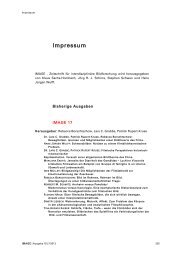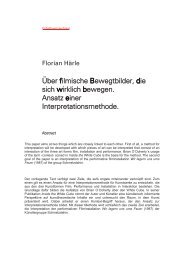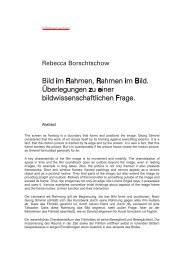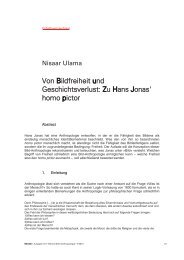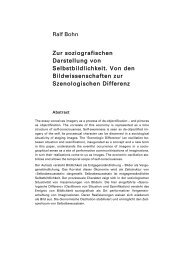Image 9 - Gesellschaft für interdisziplinäre Bildwissenschaft
Image 9 - Gesellschaft für interdisziplinäre Bildwissenschaft
Image 9 - Gesellschaft für interdisziplinäre Bildwissenschaft
Erfolgreiche ePaper selbst erstellen
Machen Sie aus Ihren PDF Publikationen ein blätterbares Flipbook mit unserer einzigartigen Google optimierten e-Paper Software.
DIETER MAURER/ CLAUDIA RIBONI/ BIRUTE GUJER: PICTURE GENESIS AND PICTURE CONCEPT<br />
for depiction as well, but not only for this kind of manifestation of the pictorial. And hand in hand<br />
with the increasing distinction between different types of the pictorial goes their mutual influence<br />
and motivation, which itself runs counter to their strict conceptual separation.<br />
Or, taking up a point made by Lorblanchet: »Pre-historians and art historians use the expressions<br />
›figurative‹, ›non-figurative‹ and ›abstract‹ in a sense prescribed to them by the Western societies<br />
of the day: their meaning is clear, and they help specialist to understand each other better at an<br />
academic level. And yet some comments need to be made about using them. Firstly, distinguishing<br />
between ›figurative‹ and ›non-figurative‹ or ›abstract‹ probably makes no sense for prehistoric<br />
people, and also makes no sense for artists from non-Western societies and traditions.«<br />
(lo R b l a n c h e t 1999: 212; translation by the authors.)<br />
If some product shows independence in relation to a physical function in its produced qualities –<br />
however limited this independence may be, and however concealed it may seem within a particular<br />
context –, then this is as a result of independent thinking, understanding, and a corresponding<br />
intention.<br />
If the distinction drawn in English between the expressions ›image‹ and ›picture‹ can be used to<br />
define the difference between ›image‹ as the generic term and ›image as a physical product that<br />
can be visually perceived‹ as a specific type of image (note: two qualifications), then the linguistic<br />
difference between the German expressions ›Bild‹ (in the sense of ›picture‹, that is, ›erzeugtes, visuell<br />
wahrnehmbares Bild‹) and ›Abbild‹ should be used to distinguish between ›picture‹, now itself<br />
a generic term and ›picture that relates analogously to figures, objects, scenes and events that<br />
can be otherwise visually perceived or imagined‹, as a specific type of picture. Observing early<br />
pictures in picture genesis leads to the claim that ›picture‹ should not be equated with ›depiction‹<br />
from the very outset. – However, this kind of distinction between ›picture‹ and ›picture that depicts‹<br />
should not gloss over the continuing conceptual problem that depictions as products have to be<br />
distinguished from depicting aspects in pictures, that pictorial analogies to the non-visual exist,<br />
and that other and varied types of picture references exist that were not discussed here at all.<br />
Thirdly – the fundamental distinction between ›picture‹ and ›ornament‹ should be abandoned.<br />
All the above arguments lead to such a claim. ›Ornament‹ as an expression can define a certain<br />
function of pictorial quality in a particular context, but is not suitable either as a term for the socalled<br />
›abstract‹ or as a counter-term to that of the picture as depiction.<br />
Fourthly – equating the expressions ›picture‹, ›pictorial‹, ›pictorial cognition‹ with the expressions<br />
›icon‹, ›iconic‹, ›iconic cognition‹ requires clarification.<br />
Equating ›picture‹ and ›icon‹ (and related expressions) requires linguistic clarification because it<br />
frequently brings together two different traditions, which can lead to a fundamental misunderstanding.<br />
On the one hand, the expression ›icon‹ is often used as a technical term for ›visual image‹, and<br />
then takes up a particular kind of debate that goes back to antiquity. On the other hand, the ex-<br />
IMAGE I Ausgabe 9 I 1/2009 36



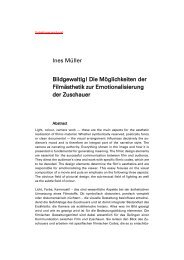
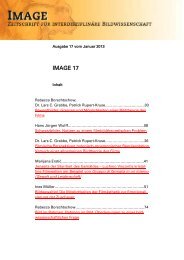
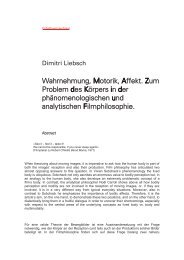
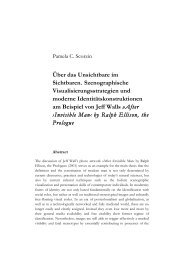
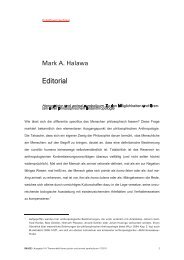
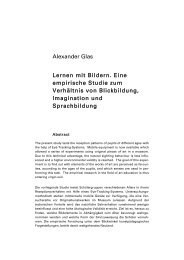
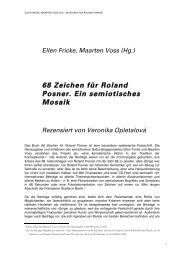
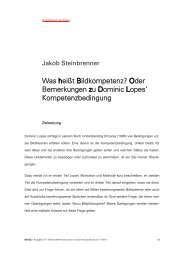
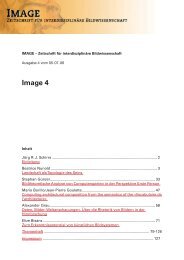
![image 11 [pdf] - Gesellschaft für interdisziplinäre Bildwissenschaft](https://img.yumpu.com/41525154/1/184x260/image-11-pdf-gesellschaft-fur-interdisziplinare-bildwissenschaft.jpg?quality=85)
